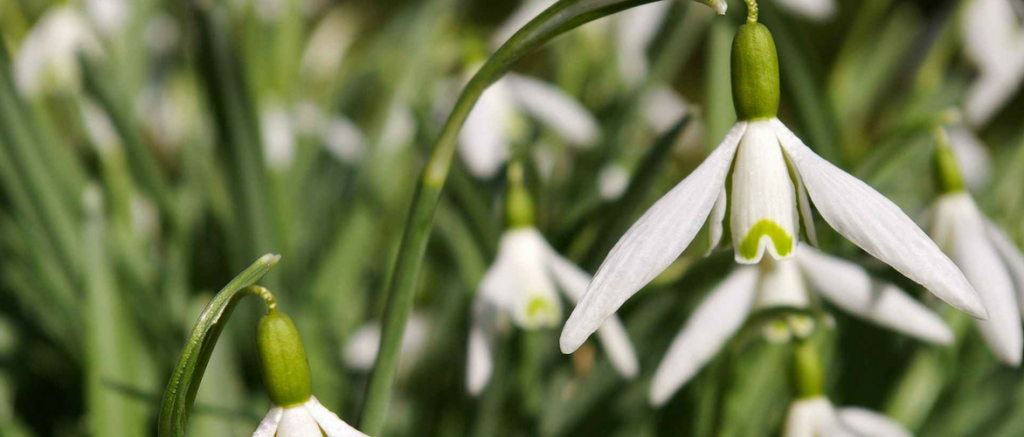
Snowdrop, Galanthus nivalis: planting, growing and care
Contents
Snowdrop in a few words
- The snowdrop is one of the first bulbs to flower at the end of winter
- Low-maintenance, hardy and prolific, it naturalises and multiplies very easily
- It thrives in large flowering carpets, borders, lawns or at the foot of trees
- It makes beautiful white potted displays heralding spring
Our expert's word
The Snowdrop or Galanthus nivalis is one of the first bulbous flowers to herald winter’s end and spring’s arrival. A symbol of renewal, its pure white little bells often piercing through the last snow, emerge from January to March, from naturalised ground-cover carpets, lawn settings, light woodland floors, the front of pathway borders, rockeries or even planters. While Snowdrops may evoke a well-known association for some, this beautiful, easy-to-grow bulb features in many naturalistic-inspired gardens.
Low-maintenance and fully hardy, it thrives almost everywhere in France, requiring no upkeep.
From the classic Galanthus nivalis Snowdrop to the giant Galanthus elwesii, and including the bright green-leaved Galanthus woronowii or the pleated-leaf Galanthus plicatus, this garden essential for the gardener-free garden flourishes in partial shade beneath shrubs, roses or deciduous trees, at woodland edges.
In well-drained soil, it naturalises easily, forming over time prolific flowering carpets or beautiful border foregrounds in early spring.
This prolific bulb brings a fresh touch to the garden when paired with other early bulbs like crocuses, squills and Leucojeum vernuum, creating vibrant displays. It thrives alongside Anemone blanda, Muscari, Hyacinths, Ipheions, Iris reticulata, Erythronium, Daffodils and early Tulips which will take over the flowering sequence. Winter Hellebores, Snow Heathers and Vinca Minor make perfect perennial companions for these small bulbs in delicate scenes.
As one can never plant enough of these small bulbs that tuck into every space and brighten grey days with their graceful blooms, discover our collection of Snowdrops with single or double flowers like the striking ‘Flore Pleno’ cultivar to brighten the garden from late winter or create delicate planters.
Botany
Botanical data
- Latin name Galanthus
- Family Amaryllidaceae (Liliaceae)
- Common name Snowdrop, Common snowdrop, Fair maids of February
- Flowering January to March
- Height 20 cm
- Exposure Sun, Partial shade
- Soil type Clay-loam
- Hardiness Beyond -15°C
The Snowdrop, Galanthus or “Fair maids of February”, is a delicate little bulbous plant from the Amaryllidaceae family, native to Asia Minor and Central Europe where it grows in rocky soils and woodland areas. It is sometimes confused with its cousin, the Spring Snowflake (Leucojum), from which it can be distinguished by its petal shape.
While the genus includes 19 species of perennial bulbous plants (not counting wild snowdrops), three are most commonly sold and cultivated in France: Galanthus nivalis, the type species; Galanthus elwesii, the giant snowdrop, about twice the size of other species; and Galanthus woronowii with its characteristic bright green foliage. There is also Galanthus plicatus, a variety more commonly found in England or Holland. Galanthus nivalis comes in numerous varieties and cultivars, some particularly interesting with double flowers like the ‘Flore Pleno’ snowdrop.
Extremely hardy, snowdrops can withstand temperatures below -15°C. They can be grown almost anywhere in France but dislike arid soils and long dry summers typical of Mediterranean climates. They thrive in contrasting climates and require a cold period to flower well.
Vigorous and very prolific, these small bulbous plants produce numerous bulbils that spread year after year. They are easy to naturalise in gardens and also self-seed spontaneously: they multiply quickly in lawns without requiring any maintenance, eventually forming pretty flowering colonies over time.
Once well-established in well-drained soil, snowdrops will flower for many years, provided the bulbs are divided every 3-4 years to maintain the plant’s longevity and flower vigour. Note that snowdrop bulbs are toxic… but only if ingested!
In winter, this herbaceous plant emerges from the ground when we’d almost forgotten about it, forming vigorous clumps 15-25 cm tall. Each bulb produces one or two stems, each bearing a small pendulous flower 2-5 cm long, facing outward from the clump.
Its flowers are among winter’s beautiful garden surprises. Their early flowering, heralding spring, awakens gardens still dormant from the cold.
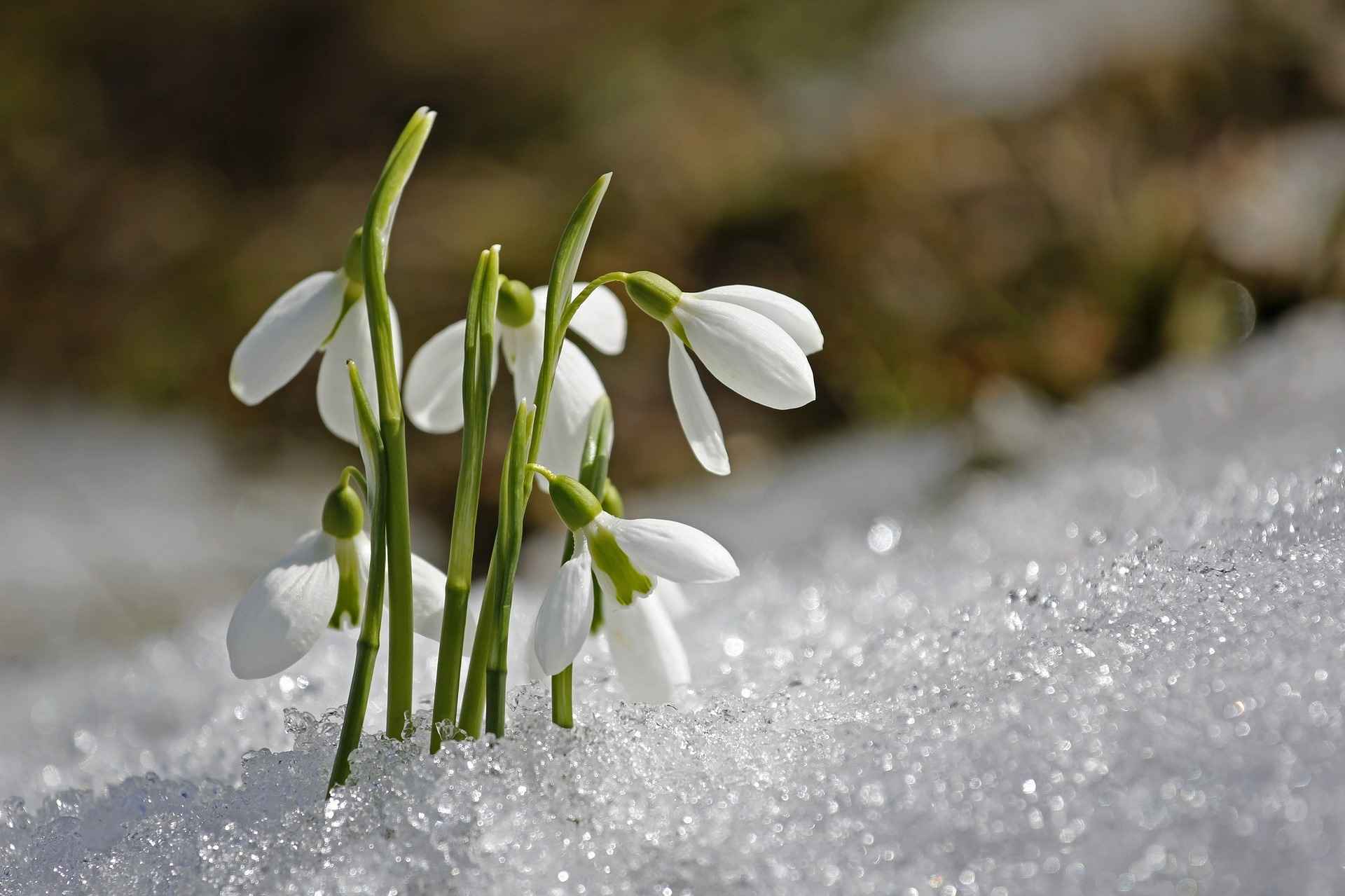
Delicate as snowflakes, Galanthus bells are the first to pierce the snowy mantle
Like crocuses (and often before them), Galanthus nivalis is one of the first flowers to bloom in late winter, sometimes as early as January, more often in February. With elegant simplicity, its small winter bells resembling milk drops often pierce through the last snow. In Greek, Galanthus nivalis literally means “milk flower”. Their flowering period extends from January to March and lasts about 3 weeks.
Delicate and airy as snowflakes, Snowdrop flowers vary by variety – they can be single or double. All feature an outer crown of three long, slightly convex outer tepals of immaculate white, sometimes marked with green at the tip, widely spread. These shelter an inner corolla hidden from view.
In single forms, the white petals’ tips bear an inverted green V mark. In showier double varieties, they crown a central rosette of white petals variegated with emerald green or marked with yellow. The nivalis pleniflorus ‘Dionysus’ variety is an unusual form with curiously shaped flowers. This little gem, considered a collector’s plant, features a small heart of frilly central petals blotched with dark green edged in white.
These delicate, nodding inflorescences, facing outward from the clump and inclined toward the ground, disappear with the arrival of spring’s first warmth. They are honey-producing and emit a light honey fragrance.
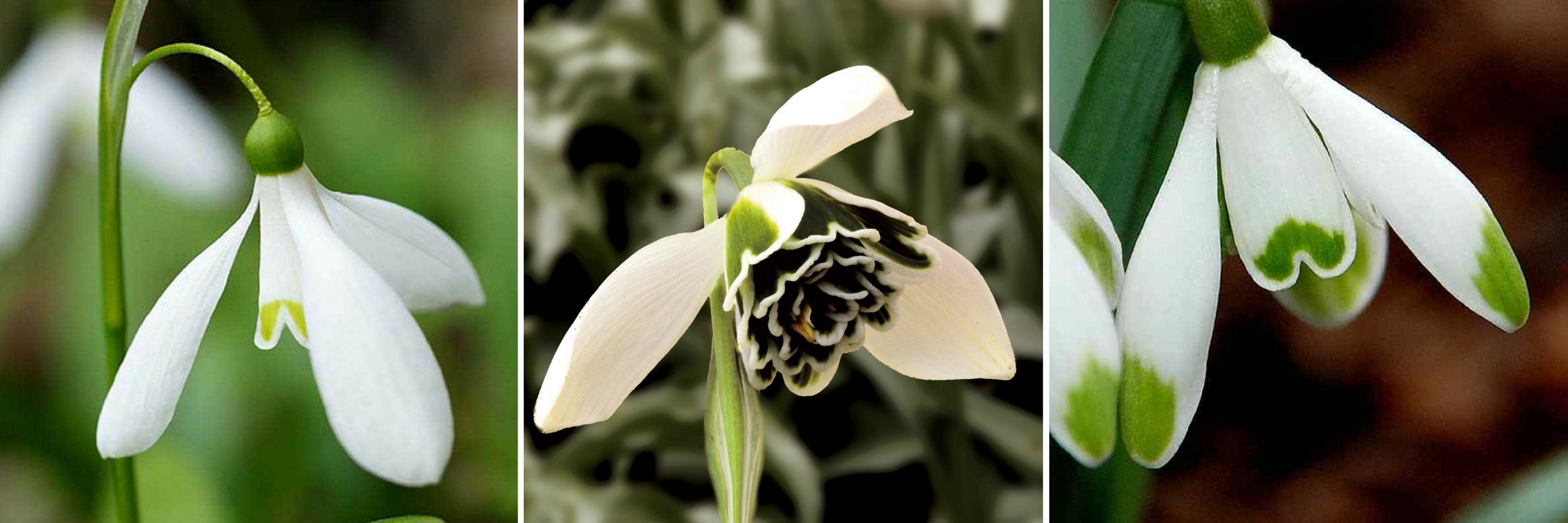
Galanthus Woronowii-G. nivalis pleniflorus ‘Dionysus’ -G.nivalis ‘Viridi’
Foliage appears early in the season. A clump of ribbon-like leaves, more or less narrow and erect, serves as a setting for this precocious flowering: the sheathed leaves at the base of the flower stalk appear in pairs and incline more or less strongly toward the ground depending on the species.
Leaf colour varies by variety, from glaucous green to very bright light green (Galanthus woronowii). Waxy in texture, sometimes slightly shiny, 5-20 cm long, some Galanthus leaves terminate in a short hood-like point. Some like Galanthus plicatus have broader leaves and, as its name suggests, shallow grooves giving them a characteristic pleated appearance. Others show a single prominent central vein. The strap-like, sometimes twisted foliage of Galanthus elwesii is more vigorous than the type species.
Deciduous, it yellows then disappears by late spring, leaving a gap in flower beds, only to return in winter.
Easy to grow and accommodating, snowdrops multiply quickly in all soils that remain cool in summer, loose, and especially well-drained in winter. They grow less well in chalky soil. They dislike heavy soils that promote bulb rot as well as overly dry summer conditions. Plant in partial shade, especially in southern regions; in cooler climates they tolerate sunny exposures. They also make excellent plants for light woodland as they flower well before deciduous trees leaf out.
These small bulbs naturalise easily, sometimes becoming invasive, which can be an asset in naturalistic gardens, for flowering light woodland or hard-to-access slopes.
Planted en masse with early crocuses in lawns, this ideal plant for large-scale naturalisation also creates beautiful flowering carpets in winter. Used as ground cover, it can colonise slopes. Planted at the base of roses or deciduous trees with Crocus tommasinianus and other bulbs or plants that will follow like winter aconites, muscari, hyacinths, daffodils, Anemone blanda, winter hellebores and squills, snowdrops contribute to fresh scenes heralding winter’s end and the approaching spring.
Small snowdrop bulbs tuck in everywhere between plants without smothering existing perennials like Bleeding Hearts, winter heathers or Bergenia, as their foliage disappears when these plants begin growing. They also thrive planted in small, dense groups at the front of borders near the house to admire their flowering, or in cool rockeries with Cyclamen coum, pansies, creeping bugle, Ipheions or small ferns. Their charming flowering also lends itself beautifully to container cultivation mixed with pansies, crocuses, muscari or primroses.
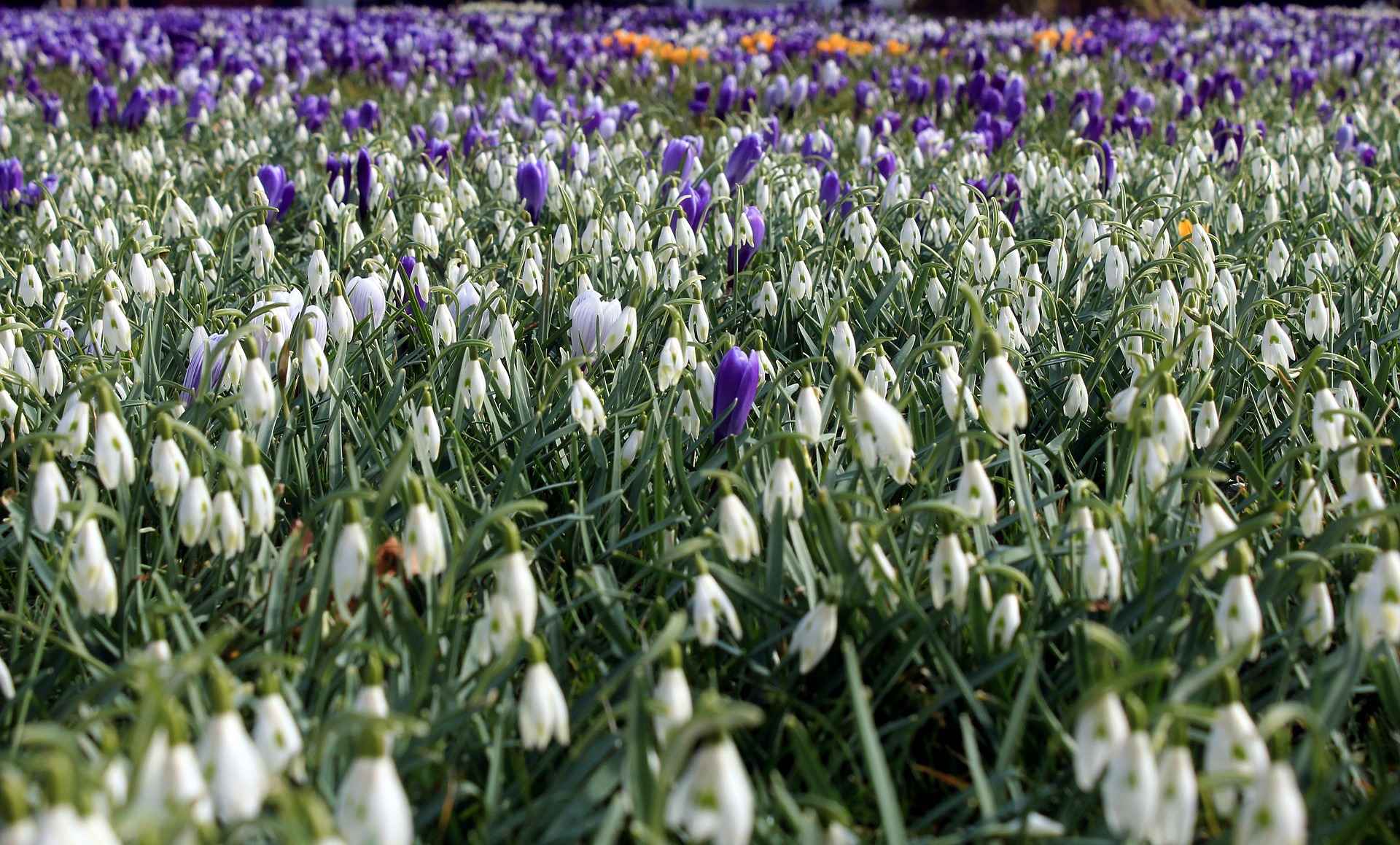
Snowdrops are ideal for large-scale naturalisation; here they create delicate flowering carpets with crocuses
Read also
How to propagate snowdrops?Species and varieties
The genus Galanthus includes 19 species of bulbous perennial plants, but in France, only a few species are most commonly sold in nurseries and grown in gardens:
- Galanthus nivalis, the typical species with glaucous foliage and small white flowers marked with green. It is the origin of many varieties and cultivars that are easily found in commerce. The most interesting cultivar is undoubtedly the double-flowered Snowdrop ‘Flore Pleno’. ‘Viridi-Apice’ is a slightly taller variety than the typical species. ‘S. Arnott’ grows more vigorously than others, reaching up to 25 cm in height, and produces large, open single white flowers.
- Galanthus elwesii, the giant snowdrop, which is about twice the size of other species.
- Galanthus woronowii, distinguished from other species by its characteristic bright, light green foliage rather than grey-green.
- Galanthus plicatus, a variety much more commonly found in England or Holland, with broad, upright, pleated green leaves that are wider than those of Galanthus nivalis.
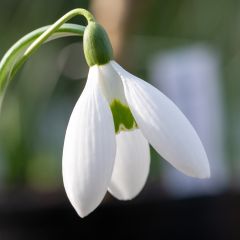
Galanthus elwesii
- Flowering time March, April
- Height at maturity 20 cm
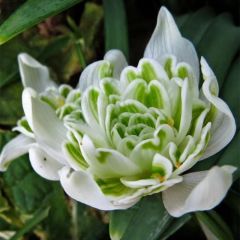
Galanthus nivalis f. pleniflorus Flore Pleno
- Flowering time March, April
- Height at maturity 15 cm
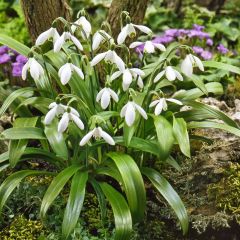
Galanthus woronowii
- Flowering time February to April
- Height at maturity 20 cm
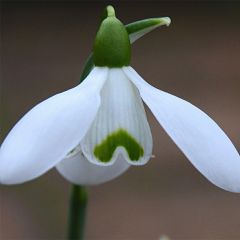
Galanthus nivalis Sam Arnott
- Flowering time April, May
- Height at maturity 25 cm
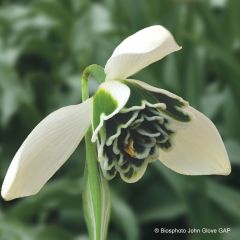
Galanthus nivalis f. pleniflorus Dionysus
- Flowering time March, April
- Height at maturity 20 cm

Galanthus nivalis Sam Arnott
- Flowering time April, May
- Height at maturity 25 cm
Discover other Galanthus - Snowdrop
Planting
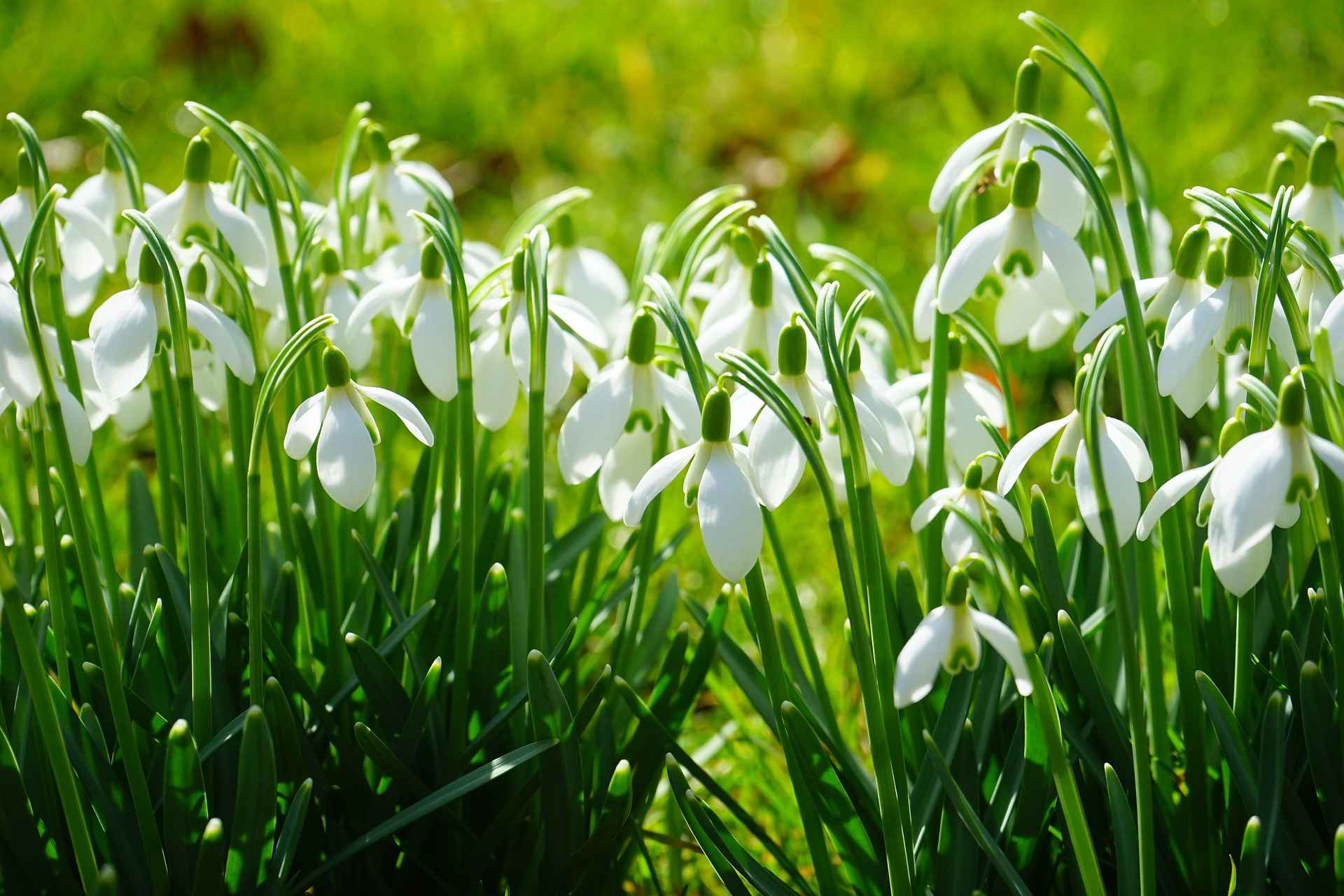
Plant Snowdrop bulbs directly in the lawn!
When to plant Snowdrops?
As soon as possible, Snowdrop bulbs should be planted early, from September to mid-October.
Where to plant Galanthus nivalis?
Snowdrops can be grown almost anywhere in France. However, they prefer contrasting climates to the long, dry summers of southern regions: their bulbs need a cold period to flower well. Highly hardy and unafraid of snow, they can withstand temperatures below -15°C.
Easy to grow, Snowdrops multiply quickly provided they are planted in soil that remains cool in summer, humus-rich and, crucially, well-drained in winter. They dislike heavy, waterlogged soils which encourage bulb rot, as well as soils dried out by intense summer heat. They can tolerate chalky soil.
Once established, their clumps will remain in place for many years, sometimes even becoming invasive.
This small bulb enjoys the coolness of partial shade, especially in Mediterranean climates. In cooler climates, it will tolerate sunny positions. Its tendency to naturalise makes it ideal for scattering across lawns in winter, creating flowering carpets or ground cover on slopes. It also thrives in light woodland under deciduous trees, along pathways or borders, in cool rockeries or in pots.
Versatile, it pairs well with certain perennials such as Bleeding Hearts, Heucheras, Snow Heathers, Pansies, and other early-flowering small bulbs that, like Snowdrops, require little maintenance and help stagger flowering times: Crocuses, Grape Hyacinths, Anemone Blanda, Hyacinths, Daffodils…
How to plant Snowdrop bulbs?
These small bulbs should be planted close together for maximum impact, in well-drained soil to prevent rotting.
-
In small groups for a natural look
Using a bulb planter, plant at a maximum depth of 8 cm, in groups of 20 to 40, spacing the groups about 10 to 15 cm apart. Opt for irregular planting for a natural decorative effect.
-
In a lawn
For planting in a lawn, cut out sections of turf, then use a bulb planter to plant at a maximum depth of 8 cm. Replace the turf sections after positioning the bulbs.
-
As a flowering carpet for a spectacular effect!
Snowdrops can serve as ground cover in partial shade or to colonise slopes. For a harmonious look, create an irregular, oval-shaped design with rounded edges.
For successful mass planting, allow for around 100 bulbs per m². Dig out part of the chosen bed area to a depth of 12 to 15 cm, then place the bulbs about 5 cm apart. Backfill “en masse”.
-
In pots
Snowdrop bulbs can easily be forced in cold conditions from autumn, allowing you to enjoy their flowers and fragrance indoors at Christmas. Don’t plant them alone—pair them with other early bulbs like Grape Hyacinths, Daffodils or Hyacinths. Add a layer of clay pebbles for perfect drainage and fill with a mix of garden soil, compost and pumice.

Care and maintenance
Low-maintenance, the Snowdrop requires no particular care. When the foliage turns yellow after 3-4 years, it’s time to lift and divide large clumps to maintain good vigour.
No pruning is necessary, though if you wish to control propagation and avoid self-seeding, cut back the flower stems after blooming. To allow the bulb time to replenish its reserves for the following spring, leave the foliage in place without cutting or mowing until it has completely withered. Only pot-grown plants require regular watering.
Learn more in our article How to care for snowdrops after flowering?
Diseases and potential pests
The Snowdrop is a robust and disease-resistant plant that, when grown in good conditions, fears little and returns faithfully year after year. The narcissus fly is its main enemy: removal of affected bulbs is mandatory in case of an attack. The other threat is grey mould caused by excess water. Well-drained soil will keep the bulbs healthy and prevent contamination by this fungus.
Propagation
The germination of Snowdrop seeds is unpredictable, especially since this bulbous plant readily self-seeds naturally. We recommend division instead, which is very simple to do and also helps maintain vigorous clumps with abundant flowering.
After 3-4 years, divide the clumps. Preferably do this during full bloom in February when the foliage is still green or just after as soon as the leaves begin to yellow.
5 secrets to successfully propagate Snowdrops
- Lift the clump with a garden fork, taking care not to damage the bulbs
- Cut away dried leaves
- Separate the bulbils one by one, by hand or with a small knife
- Replant the bulbs immediately at 5-8 cm depth in well-drained soil
- Firm the soil and water
Pair with
Snowdrops are easy-to-grow flowering bulbs that pair beautifully with a multitude of equally low-maintenance plants. Discreet yet reliable, they spread effortlessly in naturalistic gardens or weekend retreats. Galanthus nivalis is perfect for colonising slopes, brightening borders, adorning lawns, creating floral carpets beneath deciduous trees or roses, crafting ephemeral pot displays, or awakening rockeries and perennial beds still drowsy from winter.
They are among the first flowers to appear in spring, alongside Crocus, Squills and Snowflakes, forming vibrant early carpets that herald spring’s arrival. They thrive alongside other spring bulbs such as Anemone sylvestris and blanda, Muscari, Hyacinths, Ipheions, Iris reticulata, Dog’s-tooth Violets, Daffodils, Jonquils and Early Tulips which bloom early in the season and will extend the flowering period.
Among perennials, Winter Hellebores, Snow Heathers, Bugleweed, Lesser Periwinkle, Primroses and the ornamental evergreen Ophiopogon create exquisite combinations with these petite bulbs in fresh, delicate displays.
They also excel in light woodland settings, flowering before Bleeding Hearts and Corydalis emerge.
Snowdrops adapt wonderfully to container cultivation – perfect for windowsills, patios or balconies when mixed with Crocus, Primroses, Pansies, Cyclamen coum and miniature Daffodils to prolong the flowering season.

Cyclamen coum, Galanthus nivalis and Eranthis – a fresh, springtime combination
To go further
Discover more:
- Our wide range of Snowdrops: featuring the finest varieties, from classic to rare
- Guide: Bulb Sizes: Understanding How to Choose Wisely
- Guide: Snowdrops: 5 Ideas for Pairing Them
- Tutorial: How to Propagate Snowdrops?
- Guide: 5 Bulbs for Early Winter Blooms
- Marion’s tips in Brighten Shady Spots with Spring Bulbs!
- Subscribe!
- Contents


































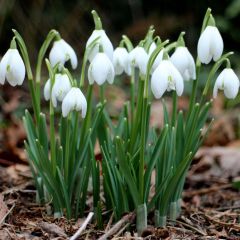
Comments